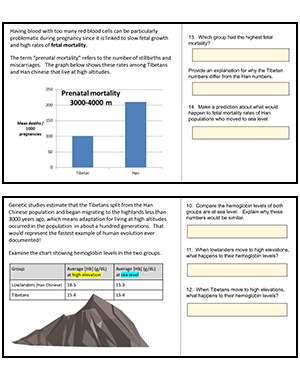
This case study is a remote alternative to “How Do Tibetans Survive High Altitudes.” The remove version is shorter and does not require as much guidance by the instructor. I created this version with Google slides, so students can type their answers directly onto the slide.
I made remote versions of several activities because I found that students just weren’t being successful with the original version. During the pandemic, many students worked on their own from home. I didn’t have the ability to walk around the classroom or help students who may be struggling with the content or graphs.
The remote versions are also shorter, because home students are more likely to not attempt work if they perceive that it will be too hard or take too long. Ideally, when students are back in class, I’ll use the original version, which is much more challenging.
Case Description

In this case study, students explore how the body can adjust to low atmospheric pressure. Adjustments, such as increasing red blood cell count, are a way for the body to maintain homeostasis. Other changes include increasing respiration and heart rates.
The case starts with a description of these mechanisms and includes questions to guide reading. Students then examine a graphic that shows a hematocrit samples. Individuals who move to high altitudes have higher amounts of red blood cells compared to plasma.
Then, students compare hemoglobin levels of lowlanders and Tibetans that illustrates how Tibetans do not actually increase red blood cell counts. In Tibetans, an altered gene, EPAS1, keeps the red blood cell numbers low. This might at first seem counterintuitive, because red blood cells increase oxygen carrying capacity.
The problem is the trade-offs in having thicker blood. High hematocrit is associated with blood clotting and fetal mortality. Students will make the connection by examining a bar graph that shows that Tibetans have fewer stillbirths. In this case, thicker blood is not an advantage.
Finally, students answer a question about how fetal mortality is a selection factor in the evolution of Tibetans. This is where they summarize what they have learned in the case.

